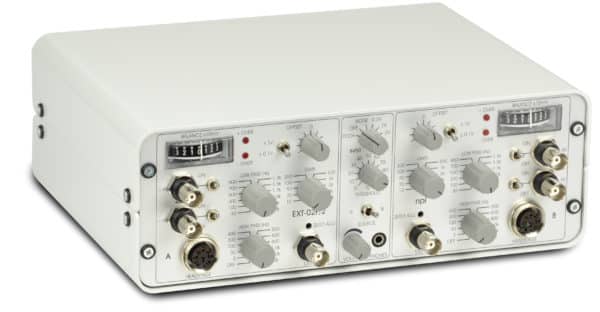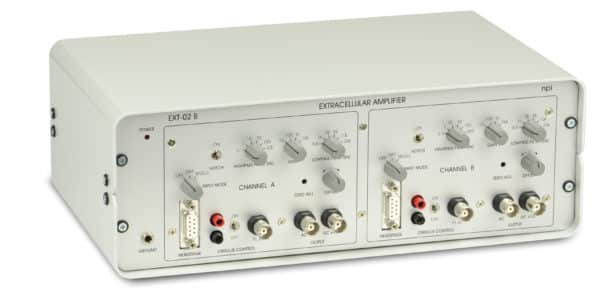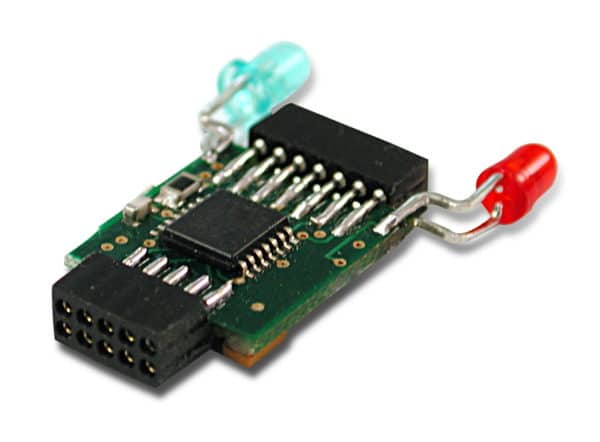Extracellular signals are a sign of the activity of electrically active tissues in electrophysiology, such as neurons, muscles, retina, etc. The measurement of extracellular signals can help to analyze and understand functions of single cells, but also of whole networks of cells. Usually, they are easier to measure than intracellular signals because it is not necessary to penetrate cells. However, the signals are much smaller and need to be highly amplified. Unfortunately, noise from the environment is also amplified and for these measurements it is often difficult to achieve good signal-to-noise ratios.
npi electronic’s electrophysiology amplifiers are built with sophisticated electronics, and feature filters and amplification of the signals of up to 10.000. External power supplies are used in all desktop version amplifiers. The EPMS housing which hosts the EXT modules is available also with an external power supply for most sensitive recording or with a shielded internal power supply which is suitable for signals >100 µV. Read more…




Normally, a headstage with differential input is used to record the electrophysiology signals which are then processed in the extracellular amplifier. This ensures low-noise recording of single units as well as recording of field potentials such as EEG, ERG, EKG. All npi extracellular amplifiers allow AC and/or DC recordings in order to give the experimenter highest flexibility. 50Hz or 60Hz Notch filters are built in and help to minimize distortion of the signals by mains hum.
Miniature headstage for mounting directly on the animal’s head are available as well. npi prefers a tethered approach for miniature headstages as this method gives maximum recording bandwidth, enough power for stimulation and is independent from batteries.
The EXT-02B series of extracellular amplifiers allows recording and stimulation with the same electrode. This is achieved through a switch that connects either an external stimulus generator or the recording amplifier to the electrode. In this way, the measuring amplifier is prevented from clipping caused by the stimulus.
The EXT-T series is made especially for recording with tetrodes.
Extracellular amplifiers are available as 19” rack-mount instrument, as small desktop devices or as modules for npi’s modular EPMS system.
Yes, npi’s EXT extracellular amplifiers are compatible with any electrophysiology data acquisition system. All relevant signals are available at BNC connectors and can easily be linked to any data acquisition interface.
In the single-ended recording configuration the signal is recorded with one electrode with reference to ground. Differential configuration means, that the signal at the output of the amplifier is the difference between the positive and negative input. This results in cancelling of all signals which both electrodes record, e.g. noise.
The TG-01H is used to test an extracellular amplifier. It is battery powered and provides small signals to be fed into the input of an extracellular amplifier. Two frequencies are available allowing basic functions of the amplifier to be checked.
The audio monitor is used to monitor the recorded signal acoustically. Two modes of operation are available. In pitch mode the voltage of the input signal is converted into a tone with a frequency equivalent to the amplitude of the input voltage. It is mostly used in DC recordings. In noise mode the voltage of the input signal is high pass filtered, amplified, and transduced to a sound. It can be used for instance to count action potentials in AC recording mode. A threshold function can be used to blank baseline noise.
Yes, it is provided by means of an additional instrument linked to the extracellular amplifier.
Almost every extracellular signal can be recorded. This includes field potentials (LFP) like EEG, EMG, EKG, ERG, EPG and Field-EPSP as well as single unit potentials like AP.
These amplifiers are available with one, two, four, eight or sixteen recording channels. Multiple channel systems especially for recording with miniature headstages are available as well.
You can do both, field potential and single unit recordings.
Yes, you can. It is easy to use in head-fixed animals. npi also provides miniature headstages for extracellular recordings in freely moving animals. Differential measurement minimizes noise in this recording environment.
npi’s EXT amplifiers usually record using headstages with high impedance input via BNC connectors. These connectors accept glass electrodes as well as metal electrodes via electrode holders or special connectors.
Yes, you can with the EXT-02B series amplifiers. They provide an input for and external stimulator. This input is also connected to the recording electrode. A switch determines whether the recoding amplifier or the stimulator is connected.
A Notch filter reduces mains hum (50 Hz or 60 Hz) in recordings caused by the electrical installations in the room or other devices.

Our dedicated team has years of industry and laboratory experience.
From complex technical challenges to tailored product recommendations,
our application scientists are ready to support your needs with hands-on expertise.